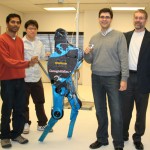Archive for Август, 2011
Американский робот стал самым быстрым бегуном в мире
- Тип контента: Новостная статья, Видео
- Номер документа: 2171
- Название документа: Американский робот стал самым быстрым бегуном в мире
- Номер (DOI, IBSN, Патент): Не заполнено
- Изобретатель/автор: Не заполнено
- Правопреемник/учебное заведение: Не заполнено
- Дата публикации документа: 2011-08-18
- Страна опубликовавшая документ: Россия
- Язык документа: Русский
- Наименование изделия: Не заполнено
- Источник: http://www.membrana.ru/particle/16599
- Вложения: Не заполнено
- Аналитик: Ридна Украина)))
 Созданная в Мичиганском университете машина развила максимальную скорость три метра в секунду (10,8 км/ч) и стала самым быстрым двуногим роботом с коленями в мире.
Созданная в Мичиганском университете машина развила максимальную скорость три метра в секунду (10,8 км/ч) и стала самым быстрым двуногим роботом с коленями в мире.
Категория: Полезное | 3 комментария »
PID admittance control for an upper limb exoskeleton
- Тип контента: Научная статья
- Номер документа: 1152
- Название документа: PID admittance control for an upper limb exoskeleton
- Номер (DOI, IBSN, Патент): Не заполнено
- Изобретатель/автор: Yu, Wen, Rosen, J., Li, Xiaoou
- Правопреемник/учебное заведение: Departamento de Control Automatico, CINVESTAVIPN, Av.IPN 2508, México D.F., 07360, México
- Дата публикации документа: 2011-08-18
- Страна опубликовавшая документ: Мексика
- Язык документа: Английский
- Наименование изделия: Не заполнено
- Источник: http://ieeexplore.ieee.org/search/freesrchabstract.jsp?tp=&a
- Вложения: Да
- Аналитик: Дмитрий Соловьев
 The unique exoskeleton system (EXO-UL7) in UCSC is controlled in two levels. The lower-level uses standard PID control. Three force sensors in the upper-level send desired trajectories to the lower-level. The impedance/admittance control can is limit both internal and contact forces. It is impossible to design a model-based impedance/admittance control when the model of theexoskeleton is unavailable. In this paper, a model-free PID type admittance control is applied, whose parameters can be designed by human impedance properties. The inverse kinematics are required when the desired trajectories generated by admittance control in task space. It is difficult to solve the inverse kinematics problem especially when the robots are redundant, such asexoskeleton system. In this paper, we put both the upper-level PID admittance control and the lower-level linear PID control in task space. Novel sufficient conditions of semiglobal asymptotic stability are proposed via stability analysis in task space. These conditions give an explicit selection method of PID gains.
The unique exoskeleton system (EXO-UL7) in UCSC is controlled in two levels. The lower-level uses standard PID control. Three force sensors in the upper-level send desired trajectories to the lower-level. The impedance/admittance control can is limit both internal and contact forces. It is impossible to design a model-based impedance/admittance control when the model of theexoskeleton is unavailable. In this paper, a model-free PID type admittance control is applied, whose parameters can be designed by human impedance properties. The inverse kinematics are required when the desired trajectories generated by admittance control in task space. It is difficult to solve the inverse kinematics problem especially when the robots are redundant, such asexoskeleton system. In this paper, we put both the upper-level PID admittance control and the lower-level linear PID control in task space. Novel sufficient conditions of semiglobal asymptotic stability are proposed via stability analysis in task space. These conditions give an explicit selection method of PID gains.
Категория: Научные статьи | 1 Комментарий »
Neurorobotic and hybrid management of lower limb motor disorders: a review
- Тип контента: Научная статья
- Номер документа: 3513
- Название документа: Neurorobotic and hybrid management of lower limb motor disorders: a review
- Номер (DOI, IBSN, Патент): 10.1007/s11517-011-0821-4
- Изобретатель/автор: Pons, J.L, Moreno, J.C., Ceres R., Antonio J. del Ama, Angel Gil Agudo, Ana de los Reyes-Guzmán
- Правопреемник/учебное заведение: Bioeng. Group, Consejo Super. de Investig. Cientificas, CSIC, Madrid, Spain
- Дата публикации документа: 2011-08-17
- Страна опубликовавшая документ: Испания
- Язык документа: Английский
- Наименование изделия: Не заполнено
- Источник: http://www.springerlink.com/content/8437841018345017/
- Вложения: Да
- Аналитик: Дмитрий Соловьев
 A neurobot (NR) is a mechatronic wearable robot that can be applied to drive a paralyzed limb. Through the application of controllable forces, a NR can assist, replace, or retrain a certain motor function. Robotic intervention in rehabilitation of motor disorders has a potential to improve traditional therapeutic interventions. Because of its flexibility, repeatability and quantifiability, NRs have been more and more applied in neurorehabilitation. Furthermore, combination of NRs with functional electrical stimulation/therapy constitutes a trend to overcome a number of practical limitations to widespread the application of NRs in clinical settings and motor control studies. In this review, we examine the motor learning principles, robotic control approaches and novel developments from studies with NRs and hybrid systems, with a focus on rehabilitation of the lower limbs.
A neurobot (NR) is a mechatronic wearable robot that can be applied to drive a paralyzed limb. Through the application of controllable forces, a NR can assist, replace, or retrain a certain motor function. Robotic intervention in rehabilitation of motor disorders has a potential to improve traditional therapeutic interventions. Because of its flexibility, repeatability and quantifiability, NRs have been more and more applied in neurorehabilitation. Furthermore, combination of NRs with functional electrical stimulation/therapy constitutes a trend to overcome a number of practical limitations to widespread the application of NRs in clinical settings and motor control studies. In this review, we examine the motor learning principles, robotic control approaches and novel developments from studies with NRs and hybrid systems, with a focus on rehabilitation of the lower limbs.
Категория: Научные статьи | Нет комментариев »
A Cyclic Robot for Lower Limb Exercise
- Тип контента: Научная статья
- Номер документа: 3332
- Название документа: A Cyclic Robot for Lower Limb Exercise
- Номер (DOI, IBSN, Патент): 10.1115/1.4004648
- Изобретатель/автор: Peshkin, M.A., DeJong B.P., Colgate, J.E.
- Правопреемник/учебное заведение: School of Engineering and Technology, Central Michigan University, Mount Pleasant, MI, USA
- Дата публикации документа: 2011-08-15
- Страна опубликовавшая документ: США
- Язык документа: Английский
- Наименование изделия: Не заполнено
- Источник: http://scitation.aip.org/getabs/servlet/GetabsServlet?prog=n
- Вложения: Да
- Аналитик: Дмитрий Соловьев
 This paper presents the design and simulation of a cyclic robot for lower-limb exercise robots. The robot is designed specifically for cyclic motions and the high power nature of lower-limb interaction—as such, it breaks from traditional robotics wisdom by intentionally traveling through singularities and incorporating large inertia. Such attributes lead to explicit design considerations. Results from a simulation show that the specific design requires only a reasonably sized damper and motor.
This paper presents the design and simulation of a cyclic robot for lower-limb exercise robots. The robot is designed specifically for cyclic motions and the high power nature of lower-limb interaction—as such, it breaks from traditional robotics wisdom by intentionally traveling through singularities and incorporating large inertia. Such attributes lead to explicit design considerations. Results from a simulation show that the specific design requires only a reasonably sized damper and motor.
Категория: Научные статьи | Нет комментариев »
An adaptive knee joint exoskeleton based on biological geometries
- Тип контента: Научная статья
- Номер документа: 174
- Название документа: An adaptive knee joint exoskeleton based on biological geometries
- Номер (DOI, IBSN, Патент): 10.1109/ICRA.2011.5979761
- Изобретатель/автор: Kok-Meng Lee, Jiajie Guo, Hui Yu, Dong-hai Wang, Can-jun Yang
- Правопреемник/учебное заведение: Institute of Mechatronic Control Engineering, Zhejiang University, 310027 China
- Дата публикации документа: 2011-08-15
- Страна опубликовавшая документ: Китай
- Язык документа: Английский
- Наименование изделия: Не заполнено
- Источник: http://ieeexplore.ieee.org/search/freesrchabstract.jsp?tp=&a
- Вложения: Да
- Аналитик: Не заполнено, Глаголева Елена
 This paper presents a dynamic model of a knee joint interacting with a two-link exoskeleton for investigating the effects of different exoskeleton designs on internal joint forces. The closed kinematic chain of the leg and exoskeleton has a significant effect on the joint forces in the knee. A bio-joint model is used to capture this effect by relaxing a commonly made assumption that approximates a knee joint as a perfect engineering pin-joint in exoskeleton design. Based on the knowledge of a knee-joint kinematics, an adaptive knee-joint exoskeleton has been designed by incorporating different kinematic components (such as a pin, slider and cam profile). This design potentially eliminates the negative effects associated with the closed leg/exoskeletonkinematic chain on a human knee. An investigation in the flexion motion of an artificial human knee joint is presented to compare performances of five exoskeleton designs against the case with no exoskeletons. Analytical results that estimate internal forces using the dynamic model (based on the properties of a knee joint) agree well with the experiments. These studies lead to an adaptive mechanism with a slider/cam as an alternative to pin joints for the exoskeleton, and illustrate the application of the model for designing an adaptive mechanism that minimizes internal joint forces due to a human-exoskeleton interaction.
This paper presents a dynamic model of a knee joint interacting with a two-link exoskeleton for investigating the effects of different exoskeleton designs on internal joint forces. The closed kinematic chain of the leg and exoskeleton has a significant effect on the joint forces in the knee. A bio-joint model is used to capture this effect by relaxing a commonly made assumption that approximates a knee joint as a perfect engineering pin-joint in exoskeleton design. Based on the knowledge of a knee-joint kinematics, an adaptive knee-joint exoskeleton has been designed by incorporating different kinematic components (such as a pin, slider and cam profile). This design potentially eliminates the negative effects associated with the closed leg/exoskeletonkinematic chain on a human knee. An investigation in the flexion motion of an artificial human knee joint is presented to compare performances of five exoskeleton designs against the case with no exoskeletons. Analytical results that estimate internal forces using the dynamic model (based on the properties of a knee joint) agree well with the experiments. These studies lead to an adaptive mechanism with a slider/cam as an alternative to pin joints for the exoskeleton, and illustrate the application of the model for designing an adaptive mechanism that minimizes internal joint forces due to a human-exoskeleton interaction.
Категория: Научные статьи | Нет комментариев »
Статистика
Категорий: 179
Статей всего: 2,003
По типу:
Видео: 36
Выдержка с форума: 1
Контактные данные: 12
Научная статья: 1388
Не заполнено: 5
Новостная статья: 317
Обзор технологии: 42
Патент: 219
Тех.подробности: 34
Тип: 1
Комментариев: 9,071
Изображений: 3,005
Подробней...
ТОР 10 аналитиков
-
Глаголева Елена - 591
Дмитрий Соловьев - 459
Helix - 218
Ридна Украина))) - 85
Наталья Черкасова - 81
max-orduan - 29
Елена Токай - 15
Роман Михайлов - 9
Мансур Жигануров - 4
Дуванова Татьяна - 3
Календарь
Авторизация
Ошибка в тексте?
Выдели её мышкой!
И нажми Ctrl+Enter